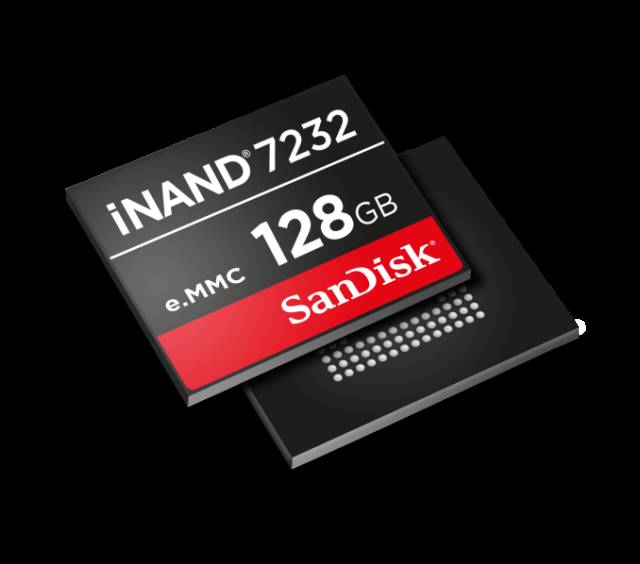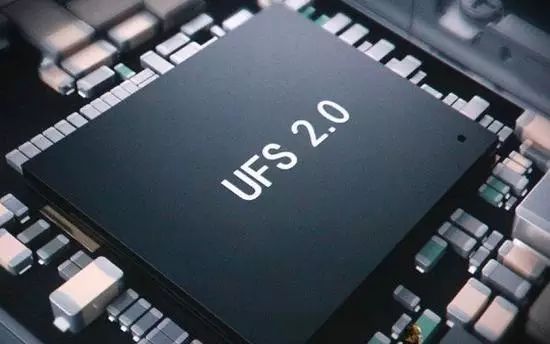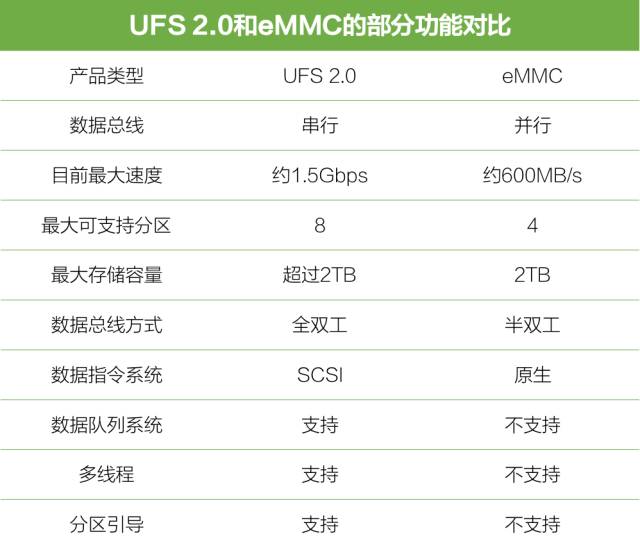A smartphone is composed of many components, and besides the processor, RAM, and graphics processor, flash memory is also a crucial indicator affecting performance and read speeds.
Recently, there has been much discussion on social networks about terms like UFS 2.0, eMMC 5.1, and LPDDR4. Most users are still unclear about what these terms mean and how they affect smartphones. Today, we will try to explain these concepts in the simplest terms possible.

Before understanding UFS 2.0, eMMC 5.1, and LPDDR4, we need to clarify the difference between memory and flash memory.
1. Memory
First, memory is one of the essential components in a computer, acting as a bridge for communication with the CPU. All program operations in a computer occur in memory, making its performance significantly impactful. The RAM in smartphones, commonly referred to as memory, stands for Random Access Memory, which is an internal storage device that directly exchanges data with the CPU, also known as main memory. It allows random read and write operations during active states, but data is lost when power is cut. Currently, mainstream smartphones generally use 2GB or 4GB of RAM, with some flagship models featuring 6GB of RAM.
On the PC platform, memory has evolved from SIMM, EDO DRAM, SDRAM, Rambus DRAM to DDR, which is now common in DDR4. In contrast, the LPDDR RAM used in smartphones stands for ‘Low Power Double Data Rate Memory,’ which, compared to desktop DDR4 memory, offers equivalent performance (speed) while consuming less energy.
2. Flash Memory
Flash memory is a form of electronic erasable programmable read-only memory that allows multiple erase or write operations during use. This technology is primarily used for general data storage and for exchanging data between computers and other digital products, such as memory cards and USB drives.
Flash memory was invented by Fujio Masuoka while working at Toshiba in 1984. Intel recognized the tremendous potential of this invention and released the first commercial NOR Flash chip in 1988. Later, Toshiba introduced NAND Flash at the International Solid-State Circuits Conference (ISSCC) in 1989.
NAND Flash has faster erase times, and its storage unit area is smaller, which provides higher storage density and lower cost per bit compared to NOR Flash. Moreover, its erase cycles are ten times higher than those of NOR Flash. It’s worth mentioning that the SSDs widely used in PCs and the ROM in smartphones are essentially the same, both being NAND flash memory.
3. eMMC
eMMC stands for ’embedded Multi Media Card,’ which is an embedded multimedia storage card. eMMC integrates a main controller on top of NAND flash memory chips and packages them into a BGA chip, significantly reducing space occupancy and wiring difficulties, making it an ideal solution for slimming down mobile devices.

The speed of eMMC depends on the bus interface. Currently, the main bus interfaces for eMMC are eMMC 4.4, eMMC 4.5, eMMC 5.0 (market mainstream), and eMMC 5.1, with theoretical bandwidths of 104MB/s, 200MB/s, 400MB/s, and 600MB/s, respectively, which looks quite good.
Note that the above data are theoretical values; the actual speed of eMMC in practical applications can be significantly lower. For example, smartphones equipped with eMMC 5.0 (like the Meizu MX5) have actual read speeds of only around 180MB/s.
 *Many factors affect actual read and write speeds, such as CPU, system optimization, and current resource usage; this data is for reference only.
*Many factors affect actual read and write speeds, such as CPU, system optimization, and current resource usage; this data is for reference only.
Due to the inherent limitations of the 8-bit parallel interface and half-duplex mode, further speed improvements for eMMC are challenging, becoming a bottleneck that hinders the overall experience of mobile devices, affecting boot speed, APP startup speed, and camera storage speed.
In addition to the difficulty in continuing to improve speed, eMMC, due to its early standardization, has gradually exposed some transmission defects, such as still using half-duplex mode, which does not support simultaneous read and write operations, lacks multi-threading, and has a maximum queue storage capacity of only 2TB.
The practical impact is that when we connect our phone to a PC, we cannot access other folders in the phone’s storage while copying photos, nor can we copy data to the phone simultaneously; we have to wait until the photo transfer is complete to perform other operations.
Looking at it now, although eMMC’s speed potential is nearly exhausted and it has certain technical issues, its performance is still not outdated; currently, eMMC 5.0 and eMMC 5.X can still meet user needs, and many smartphones continue to use eMMC. However, according to our statistics, there are now very few flagship models still using the eMMC standard, as most have adopted the faster and better-performing UFS 2.0 or even UFS 2.1; for instance, Huawei’s Mate 9 128G high-end version uses UFS 2.1.
4. UFS
UFS stands for Universal Flash Storage, which was first introduced in February 2011. However, UFS 1.1 was not very fast, with only 300MB/s. At that time, eMMC was still developing, and due to cost and compatibility issues, UFS 1.1 did not gain widespread adoption and eventually disappeared.
Subsequently, the Joint Electron Device Engineering Council (JEDEC) released the new UFS 2.0 standard. Compared to the previous standard, the new UFS 2.0 has two versions, with UFS 2.0 HS-G2 offering a theoretical bandwidth of 5.8Gbps (approximately 740 MB/s), and the faster UFS 2.0 HS-G3 achieving a theoretical bandwidth of 11.6Gbps (about 1.5GB/s), which is even faster than some SSDs, nearly 2.5 times faster than the current fastest eMMC 5.X.

This high speed can significantly enhance the speed of data access during system operation, reduce waiting times, improve efficiency, enhance energy efficiency, and even positively affect the battery life of mobile devices. It can also easily support the currently popular 4K video recording. Furthermore, when using high-speed USB 3.0 Type-C or Apple’s Lightning interface to transfer data, the bottleneck is no longer the storage chip, allowing data to be transferred faster to the target device, greatly saving time.
Compared to traditional eMMC, UFS 2.0 has five significant advantages beyond speed.
First, UFS 2.0’s transmission technology has changed to serial, which is one of the core changes.This change results in strong anti-interference capability during data transmission, and serial speeds can also be improved through multiple parallel channels.
Additionally, after switching to a serial bus, UFS 2.0 no longer uses the half-duplex method of eMMC but instead uses full-duplex mode, allowing data to be sent and received simultaneously.That is to say, when we connect our phone to a PC, we can access other folders while copying photos and can simultaneously transfer data to the phone without waiting for the photo transfer to finish.
 *UFS 2.0 uses serial transmission with two channels, supporting simultaneous read and write operations, making it faster and more efficient than the parallel transmission of eMMC.
*UFS 2.0 uses serial transmission with two channels, supporting simultaneous read and write operations, making it faster and more efficient than the parallel transmission of eMMC.
Third, UFS 2.0’s data command system is based on the SCSI structure, while the previous eMMC was based on a native architecture, which is evidently more intelligent.
Fourth, UFS 2.0 offers better storage support. The previous eMMC used a 32-bit address bus, supporting a maximum storage space of 2TB. In contrast, UFS 2.0 adopts a more flexible processing method with a greater number of address buses, easily exceeding 2TB in maximum capacity. Moreover, UFS 2.0 supports up to eight partitions.
Finally, let’s look at power consumption. While UFS 2.0 is much faster and has more complex features than eMMC, there is no significant increase in power consumption. However, it is important to note that UFS 2.0’s higher speed and support for numerous intelligent configurations mean that for the same tasks, UFS 2.0’s completion speed is much higher, which implies reduced power consumption due to increased efficiency, leading to overall energy savings.

In summary, UFS is much stronger than eMMC in terms of speed, performance, and power consumption, but correspondingly, its cost is also higher than that of eMMC.
In March last year, JEDEC released UFS 2.1, an iteration of UFS 2.0 that made some improvements over earlier versions, with UFS 2.1’s read performance exceeding that of UFS 2.0 by a factor of two, and write performance also significantly improved.
DDR/LPDDR
As mentioned earlier, on the PC platform, memory has evolved from DDR, DDR2, to DDR3, with higher frequencies and lower voltages, while latency has been steadily increasing, gradually changing the memory subsystem. DDR4’s primary mission is to increase frequency and bandwidth, with each pin providing 2Gbps (256MB/s) bandwidth, reaching frequencies up to 4266MHz and maximum memory capacity of 128GB, while normal operating voltage can be reduced to 1.2V or 1.1V.
Compared to DDR’s standard voltage, LPDDR’s operating voltage (working voltage) is lower. From the first generation of LPDDR to the current LPDDR4, each generation of LPDDR has doubled internal read sizes and external transfer speeds. Among them, LPDDR4 can provide 32Gbps bandwidth, with input/output interface data transfer speeds up to 3200Mbps, and voltage reduced to 1.1V. The latest LPDDR4X is similar to LPDDR4 but saves additional power by lowering the I/O voltage to 0.6V instead of 1.1V, making it even more energy-efficient.

In summary, LPDDR4 has greater bandwidth, lower power consumption, and higher frequency compared to LPDDR3. Currently, most flagship models use LPDDR4, though there are exceptions.
*References
Zhang Zhiyan. “The Great Revolution in Mobile Storage: A Comprehensive Look at UFS Technology” [J]. Microcomputer, 2015(18):103-106.
Jian Sheng. “The Successor to eMMC: What Can UFS Bring to Mobile Devices” [J]. Computer Enthusiast, 2016(9):104-106.
Some content sourced from IT Home.